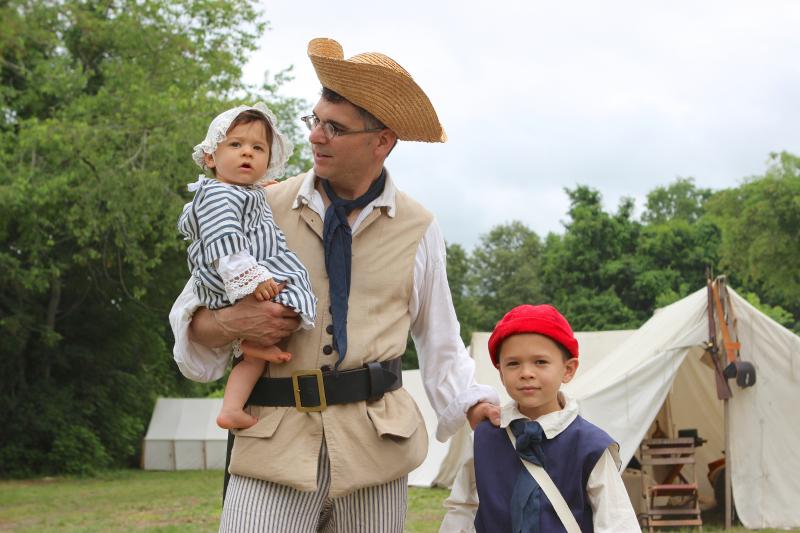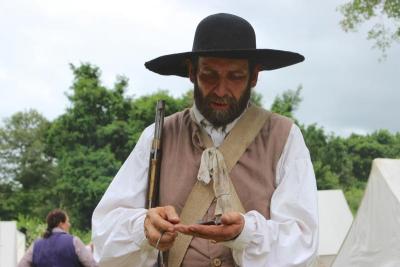Re-enactors make “Redcoats and Residents” something to remember


If you made it out around Town Green this weekend, you’d notice a group of people dressed up in 18th-century garb, speaking in outdated terms (huzaaah!!!), and using tools and technology sinced replaced by today’s modern inventions.
But stop and chat with some of the folks in town for “Redcoats and Residents,” a celebration to honor the 200th anniversary of the British invasion on Wareham, and you’ll come to find out that the re-enactors are people devoted to the preservation of American history by bringing it to the general public.
Ann Lopes travels with the 13th Continental Regiment of Massachusetts (from the greater-Rehobeth area), though she’s not in the militia, nor is she one of the camp-following wives with the group.
Ann plays a vagrant widower, cast out of the group when her “husband” was killed in battle.
“They (the widows) were discarded,” said Lopes as she solicited bystanders with goods she had stolen, sometimes off the backs of “dead” soldiers in one of their mock battles. “You were on your own.”
“I’ll do anything that I can do to survive day to day,” she added.
That includes selling stolen goods such as shoes or a belt, or catching dogs for food.
“Dogs make good eatin’,” she said when a spectator passed by with his dog, while she also attempted to peddle some of her stolen goods. “(The belt is) good for wearin’ but it’s ever better for whoopin’.
Lopes spent much of the day terrorizing both the British and American encampments around Town Green Saturday, and could be seen robbing some of the fallen Minutemen as they simulated a battle of the times.
No encampment or battle could have taken place in those times without supplies, and one of those present for bringing some of the “supplies” to Wareham was Lloyd Perry of Dartmouth. Perry brought his Revolutionary-style wagon fully equipped with commissary ranging from tents and poles to dry goods and wet goods.
Perry said he would have been known as a “wagon master” or a “wagon drover” in those days.
“A camp of this size (there were at least 20 tents in the American encampment) would have at least three or four wagons, and officers would have their own wagons to travel in,” said Perry.
Perry showed how in the American camp, there were two types of tents: a Captain’s “wall tent,” and the soldiers’ “wedge tent,” noting that there were typically six men to a tent, and food was rationed out by tent with a cook designated for each.
Throughout the American camp, period-specific supplies from grills, buckets, tents, tables, cups, bowls, and more could be seen, and the camp-following ladies from the 13th Regiment were even researching 18th-style cooking from a reprinted cookbook from the era.
“One recipe showed two different ways to prepare turtle,” said Kirsten Dody. “Every piece from the beak to the flipper was used.”
Dody said that at the time, there was no standard unit of measurement in America, and things like “a knuckle,” for instance, were used instead of measuring cups.
Charlie Jette, another member of the 13th Regiment, said his group was not well-liked by George Washington, the General of the Continental Army during the Revolutionary War.
“He liked us as a regiment, but he didn't like us as personally, since he was from Virginia,” said Jette. “He thought us very course.”
“It was a different world back then,” he added, speaking to the difference between life now and in the late 1700s and early 1800s. “People didn’t know about sanitation or germs. A lot of people died young.”
Jette could be seen using what is called a “tri-tool” to get his “flint lock musket” gun ready for the mock battle Saturday afternoon.
He said the re-enactors must go through weapons inspections both before and after battle.
“There are strict safety rules. If things are wrong with your gun, you can’t play.”
In the King's camp, Dr. Dan Newman displayed a typical day for a British doctor assigned to the battles in America.
“Here’s your anesthetic,” said Newman to young spectator Calvin Sylvia, as he handed him a small length of wood. “Bite down on that and have four or five guys hold you down and you’re good to go.”
Newman then proceeded to “amputate” Sylvia’s arm – a procedure which could be completed in under a minute by the doctors of the day.
“It was a little messy,” said Sylvia with a laugh after his operation.
Along with the British encampment and the large American encampment (which included the Wareham Minuteman Militia of around 10 or so Wareham residents), the young Wareham Fife & Drum group made several passes along Main Street in full period garb playing songs of the day, including a rendition of “Yankee Doodle.”
“I hate that song,” mused one Redcoat.
Howie Smith, a member of the Wareham Militia, said that organizing and getting settled into the encampment was a little hectic with the rain on Friday night, yet he said it was all well worth the effort put forth by the nearly 30 volunteers in charge of organizing and fundraising for all of the Summer of Celebration’s events.
“I’d like to do something like this every year—we’ll see, but it would be fun,” he said.
Outside the Tremont Nail factory, visitors could also observe and take part in a variety presentations from tradespeople of the day, including basket weavers, blacksmiths, and sailmakers, giving a further glimpse into the history of Wareham and the early days of the United States.
“I thought it was very interesting,” said Clement Smith, who took the tour at Tremont Nail. “It’s a fascinating thing to see.”





















